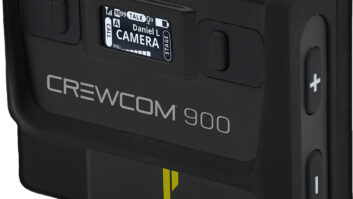Whether the project is live or installed sound, whether it calls for a customized solution or an off-the-shelf option that provides ease of use and no learning curve, there are a number of consoles and processors that fit the bill.
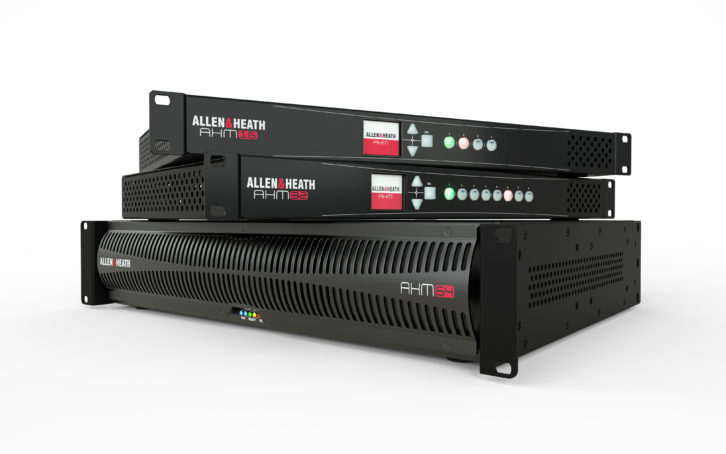 The Allen & Heath range of AHM Audio Matrix Processors suits fixed installation projects for multiroom audio distribution. The original AHM-64 has been used at the heart of many installations from churches to large global media networks, and with the recent introduction of the smaller footprint AHM32 and AHM-16 matrix processors, integrators can quickly create systems that build from a single boardroom to a complete campus. Supported by scalable I/O, control and Dante solutions, optional Acoustic Echo Cancellation (AEC) module, and including 8-band PEQ, gate, compressor and delay on all input channels, and 8-band PEQ, 30-band GEQ, compressor, ANC, source selector, limiter, and delay on all zone outputs
The Allen & Heath range of AHM Audio Matrix Processors suits fixed installation projects for multiroom audio distribution. The original AHM-64 has been used at the heart of many installations from churches to large global media networks, and with the recent introduction of the smaller footprint AHM32 and AHM-16 matrix processors, integrators can quickly create systems that build from a single boardroom to a complete campus. Supported by scalable I/O, control and Dante solutions, optional Acoustic Echo Cancellation (AEC) module, and including 8-band PEQ, gate, compressor and delay on all input channels, and 8-band PEQ, 30-band GEQ, compressor, ANC, source selector, limiter, and delay on all zone outputs
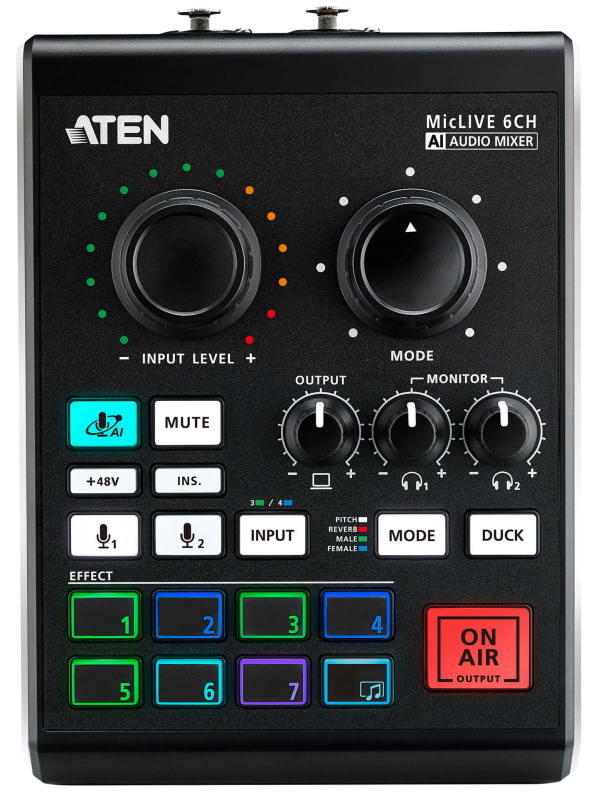 The MicLIVE 6-CH UC8000 is an all-in-one design that simplifies the audio mixing workflow for podcasting, offers up to 6-channel audio inputs, DSP and AD / DA converter, and adds audio up to 24-bit / 96 kHz to any USB-C-enabled laptop or tablet. In addition, it features enhanced microphone audio quality with enhanced acoustic models, and SmartEQ to produce a realtime high-quality recording, an autoducking function, and jingle pads that save up to 8 sound effects that can be customized from audio sources from a computer, microphone, and other audio inputs for a professional radio programming experience.
The MicLIVE 6-CH UC8000 is an all-in-one design that simplifies the audio mixing workflow for podcasting, offers up to 6-channel audio inputs, DSP and AD / DA converter, and adds audio up to 24-bit / 96 kHz to any USB-C-enabled laptop or tablet. In addition, it features enhanced microphone audio quality with enhanced acoustic models, and SmartEQ to produce a realtime high-quality recording, an autoducking function, and jingle pads that save up to 8 sound effects that can be customized from audio sources from a computer, microphone, and other audio inputs for a professional radio programming experience.
 In February, the Audio-Technica ATDM-0604a Digital SmartMixer debuted, an update of the popular ATDM-0604. The ATDM-0604a offers advanced functionality for use in a wide variety of applications, from meeting spaces to educational facilities. Incorporating user feedback from leading system integrators, the enhanced functions of the new model bring improved performance for online or live meetings. Improvements include enhanced echo and noise-cancellation performance; LED-based remote control of the Audio-Technica ES954 hanging microphone array via the GPO terminal; cascade connectivity for up to eight mixers sharing audio buses and SmartMix controls; and mic/line level support for input channels 1 to 6. The SmartMixer technology allows channels to be mixed automatically in gate or gain-sharing mode, ensuring consistent output from all inputs in a setup. In addition to a Web Remote interface, controls and LED indicators on the mixer’s front panel support: adjustment for input/output and gain levels; set and recall presets; on/off for phantom power, low-cut filter, automatic mixing and acoustic echo cancellation (AEC) by channel; IP configuration changes (Auto or Static); noise cancellation assignments, and more. DSP is available for inputs and outputs. Input processing includes a four-band parametric EQ, compressor/de-esser. Eight 8-band feedback suppressors can be assigned to an input or output. Output processing includes a 12-band parametric EQ, compressor, and limiter. IP-based external remote control are supported.
In February, the Audio-Technica ATDM-0604a Digital SmartMixer debuted, an update of the popular ATDM-0604. The ATDM-0604a offers advanced functionality for use in a wide variety of applications, from meeting spaces to educational facilities. Incorporating user feedback from leading system integrators, the enhanced functions of the new model bring improved performance for online or live meetings. Improvements include enhanced echo and noise-cancellation performance; LED-based remote control of the Audio-Technica ES954 hanging microphone array via the GPO terminal; cascade connectivity for up to eight mixers sharing audio buses and SmartMix controls; and mic/line level support for input channels 1 to 6. The SmartMixer technology allows channels to be mixed automatically in gate or gain-sharing mode, ensuring consistent output from all inputs in a setup. In addition to a Web Remote interface, controls and LED indicators on the mixer’s front panel support: adjustment for input/output and gain levels; set and recall presets; on/off for phantom power, low-cut filter, automatic mixing and acoustic echo cancellation (AEC) by channel; IP configuration changes (Auto or Static); noise cancellation assignments, and more. DSP is available for inputs and outputs. Input processing includes a four-band parametric EQ, compressor/de-esser. Eight 8-band feedback suppressors can be assigned to an input or output. Output processing includes a 12-band parametric EQ, compressor, and limiter. IP-based external remote control are supported.
 Biamp’s conferencing room systems based on Biamp TesiraFORTÉ X and Devio SCX processors are certified for Microsoft Teams Rooms. Devio SCX leverages the popular Devio platform, which debuted five years ago to automatically tune audio for BYOM. Originally designed for huddle rooms and smaller conference spaces, Devio SCX expands the range to medium and large conference spaces with two different channel count models. TesiraFORTÉ X Series is a range of premium openarchitecture meeting room processors designed to accommodate demanding conferencing applications in which customization is essential, bringing TesiraFORTÉ systems to a single compact device available in three different channel counts and with Dante and AVB support. Both TesiraFORTÉ X processors and Devio SCX are simple to set up with Biamp Launch.
Biamp’s conferencing room systems based on Biamp TesiraFORTÉ X and Devio SCX processors are certified for Microsoft Teams Rooms. Devio SCX leverages the popular Devio platform, which debuted five years ago to automatically tune audio for BYOM. Originally designed for huddle rooms and smaller conference spaces, Devio SCX expands the range to medium and large conference spaces with two different channel count models. TesiraFORTÉ X Series is a range of premium openarchitecture meeting room processors designed to accommodate demanding conferencing applications in which customization is essential, bringing TesiraFORTÉ systems to a single compact device available in three different channel counts and with Dante and AVB support. Both TesiraFORTÉ X processors and Devio SCX are simple to set up with Biamp Launch.
 The eight-channel Bose T8S ToneMatch mixer and the four-channel T4S ToneMatch mixer are compact and portable. Their enclosures have a protective, magnetically coupled cover to protect controls and connectors. A chassis-bottom insert allows the use of standard mounting accessories to keep the mixers in reach during performances. The T8S is intuitive to operate, with illuminated, stagefriendly tactile controls, an easy-to-read display, and scene recall. ToneMatch processing provides presets with the DSP engine, including effects and Bose zEQ equalization. The T4S offers most of the same features as the T8S, but also includes dual ToneMatch links, designed to send digital audio to L1 Model 1S/II systems while receiving power on the same provided ToneMatch cable.
The eight-channel Bose T8S ToneMatch mixer and the four-channel T4S ToneMatch mixer are compact and portable. Their enclosures have a protective, magnetically coupled cover to protect controls and connectors. A chassis-bottom insert allows the use of standard mounting accessories to keep the mixers in reach during performances. The T8S is intuitive to operate, with illuminated, stagefriendly tactile controls, an easy-to-read display, and scene recall. ToneMatch processing provides presets with the DSP engine, including effects and Bose zEQ equalization. The T4S offers most of the same features as the T8S, but also includes dual ToneMatch links, designed to send digital audio to L1 Model 1S/II systems while receiving power on the same provided ToneMatch cable.
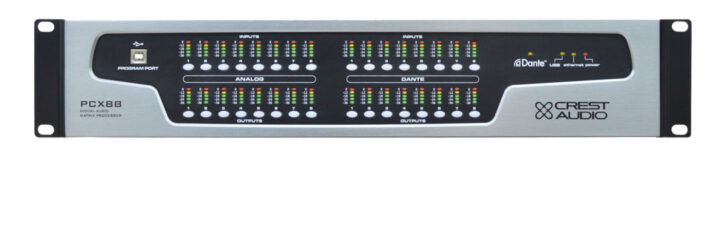 The Crest Audio PCX Series of digital matrix speaker management processors includes three units of processing technology with I/O outputs that can be routed in multiple configurations to meet virtually any requirement. They perform loudspeaker management functions as well as matrix mixing, room combining, and other audio processing functions; the PCX Series is well-suited for installed and portable sound systems. The PCX 260 offers 2 XLR inputs and 6 XLR outputs; the PCX 480 offers 4/8 XLR I/Os; and the PCX 88 offers 8/8. Notably, on the PCX 88, an additional 8 digital input channels and 8 digital output channels, all independently assigned, are available over Ethernet with the optional Dante network audio card. On each PCX Series processor, the crossover filters are fully adjustable and any input can be routed to any output via the digital matrix system, allowing for any speaker management cabinet configuration.
The Crest Audio PCX Series of digital matrix speaker management processors includes three units of processing technology with I/O outputs that can be routed in multiple configurations to meet virtually any requirement. They perform loudspeaker management functions as well as matrix mixing, room combining, and other audio processing functions; the PCX Series is well-suited for installed and portable sound systems. The PCX 260 offers 2 XLR inputs and 6 XLR outputs; the PCX 480 offers 4/8 XLR I/Os; and the PCX 88 offers 8/8. Notably, on the PCX 88, an additional 8 digital input channels and 8 digital output channels, all independently assigned, are available over Ethernet with the optional Dante network audio card. On each PCX Series processor, the crossover filters are fully adjustable and any input can be routed to any output via the digital matrix system, allowing for any speaker management cabinet configuration.
 The Crest Audio XD-16 and XD-28 digital mixers are small format, 2U rackmount mixers available in either 16- or 28-channel frames. XD Series digital mixers offer optional Dante networking as well as realtime remote control and monitoring from any Android, Windows, or iOS device. The range of configurations available enables use as a simple FoH mixer, a monitor mixer, a personal monitor mixer, or a combination of all three. An integrated WiFi module enables real-time control and monitoring of the mixer processing functions, either by acting as a WiFi router for direct connection of up to four external devices for remote control, or alternatively by connecting to an external WiFi network. The optional 4×4 Dante network module allows up to eight channels (4-in/4- out) of audio streaming over a Dante network, and also extends the physical inputs of the XD-16/XD-28 by four aux channels as well as adding four outputs. Control is provided via the Dante Controller application
The Crest Audio XD-16 and XD-28 digital mixers are small format, 2U rackmount mixers available in either 16- or 28-channel frames. XD Series digital mixers offer optional Dante networking as well as realtime remote control and monitoring from any Android, Windows, or iOS device. The range of configurations available enables use as a simple FoH mixer, a monitor mixer, a personal monitor mixer, or a combination of all three. An integrated WiFi module enables real-time control and monitoring of the mixer processing functions, either by acting as a WiFi router for direct connection of up to four external devices for remote control, or alternatively by connecting to an external WiFi network. The optional 4×4 Dante network module allows up to eight channels (4-in/4- out) of audio streaming over a Dante network, and also extends the physical inputs of the XD-16/XD-28 by four aux channels as well as adding four outputs. Control is provided via the Dante Controller application
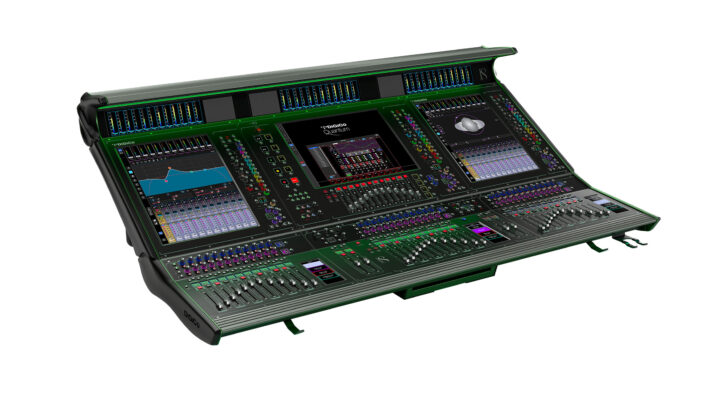 In May, DiGiCo launched its new flagship live audio production mixing console, designed from the ground up. DiGiCo Quantum852 claims a significant leap forward in processing power. It’s packaged with 1000-nit LCD screens for full daylight operation and a newly designed worksurface. DiGiCo is leaning hard on the eco credentials of this new model: lightweight alloy construction reduces weight and transport impact and many of the materials are described as sustainable and recyclable. It has a reduced operating power, thermal cooling fans along with convection cooling, and temperature-dependent cooling. Technically speaking the console features fully redundant processing, each engine is powered by five of the latest seventh-generation FPGAs and next-generation SHARC DSP processors. Quantum852’s input count increases to 384 mono channels, with 192 Aux / Sub-Group busses, plus the familiar LR / LCR / 5.1 Master busses. It comes with a 64 x 64 Processing Matrix, 36 Control Groups, two Solo busses and 64 FX Rack slots. There are 48 Graphic EQs, 384 Nodal Processors, 128 Mustard Processors and 32 Spice Racks. The Ultimate “Stadius” modular LOCAL I/O incorporates each of the three cards providing four Stadius Mic-Pres, four Stadius Line Outputs and two Bit Perfect AES I/O. On the back of each engine are eight single or four redundant BNC MADI ports, Word Clock, AES Sync, and Video Sync inputs, Dual USB 2.0 sockets, a SuperSpeed USB 3.0 socket, 4k DisplayPort Overview Out, 5-Port 1Gbps network switch, Dual DMI slots, Waves SoundGrid port and Optocore inputs as standard, with space for an optional second Optocore loop. In addition to the three 21.3-inch, all-new daylight-bright screens, there are also three 19.2-inch dedicated meter bridge screens, three dedicated 6.8-inch control screens for bank and layer switching, and 69 1.3-inch worksurface screens, all of which are touch sensitive for channel selects and solos.
In May, DiGiCo launched its new flagship live audio production mixing console, designed from the ground up. DiGiCo Quantum852 claims a significant leap forward in processing power. It’s packaged with 1000-nit LCD screens for full daylight operation and a newly designed worksurface. DiGiCo is leaning hard on the eco credentials of this new model: lightweight alloy construction reduces weight and transport impact and many of the materials are described as sustainable and recyclable. It has a reduced operating power, thermal cooling fans along with convection cooling, and temperature-dependent cooling. Technically speaking the console features fully redundant processing, each engine is powered by five of the latest seventh-generation FPGAs and next-generation SHARC DSP processors. Quantum852’s input count increases to 384 mono channels, with 192 Aux / Sub-Group busses, plus the familiar LR / LCR / 5.1 Master busses. It comes with a 64 x 64 Processing Matrix, 36 Control Groups, two Solo busses and 64 FX Rack slots. There are 48 Graphic EQs, 384 Nodal Processors, 128 Mustard Processors and 32 Spice Racks. The Ultimate “Stadius” modular LOCAL I/O incorporates each of the three cards providing four Stadius Mic-Pres, four Stadius Line Outputs and two Bit Perfect AES I/O. On the back of each engine are eight single or four redundant BNC MADI ports, Word Clock, AES Sync, and Video Sync inputs, Dual USB 2.0 sockets, a SuperSpeed USB 3.0 socket, 4k DisplayPort Overview Out, 5-Port 1Gbps network switch, Dual DMI slots, Waves SoundGrid port and Optocore inputs as standard, with space for an optional second Optocore loop. In addition to the three 21.3-inch, all-new daylight-bright screens, there are also three 19.2-inch dedicated meter bridge screens, three dedicated 6.8-inch control screens for bank and layer switching, and 69 1.3-inch worksurface screens, all of which are touch sensitive for channel selects and solos.
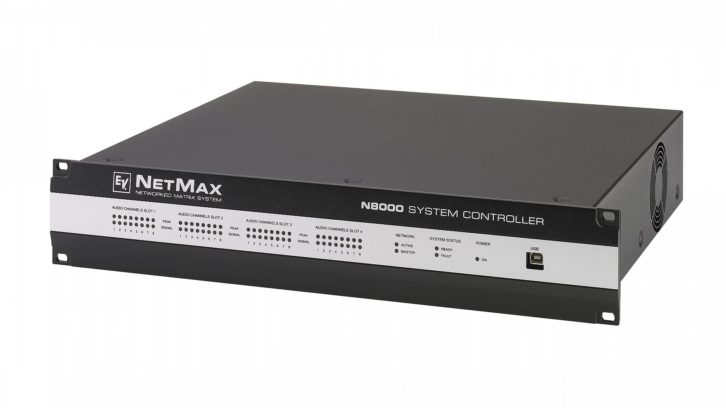 The Electro-Voice N8000 NetMax 300 MIPS digital matrix controller delivers full IRIS-Net supervision, control, and scheduling along with up to 32 input channels, extensive DSP, and CobraNet audio and control connections. It offers support for ethernet, RS-232, USB, and CAN, and Dante audio networking options are available. Four slots with 8-channel audio modules form the foundation for flexible customization, and each slot can house input or output cards. It includes internal 48-bit processing, and the auto-compiling DSP engine has ultra-low fixed latency. One time or regularly scheduled events can be arranged and reactions to certain events or system states can be configured. Any system problems can be detected automatically and can be displayed on the PC screen or transmitted to external sites.
The Electro-Voice N8000 NetMax 300 MIPS digital matrix controller delivers full IRIS-Net supervision, control, and scheduling along with up to 32 input channels, extensive DSP, and CobraNet audio and control connections. It offers support for ethernet, RS-232, USB, and CAN, and Dante audio networking options are available. Four slots with 8-channel audio modules form the foundation for flexible customization, and each slot can house input or output cards. It includes internal 48-bit processing, and the auto-compiling DSP engine has ultra-low fixed latency. One time or regularly scheduled events can be arranged and reactions to certain events or system states can be configured. Any system problems can be detected automatically and can be displayed on the PC screen or transmitted to external sites.
 The Extron DMP 128 Plus and DMP 64 Plus audio processors are certified for Microsoft Teams. The DMP 128 Plus AT models support Dante Domain Manager, compatibility with the VoIP MS cloud-based VoIP system for the DMP 128 Plus V models. Extron DMP processors are also compatible with the Avaya XI workplace solutions. Extron is committed to broad compatibility for these processors.
The Extron DMP 128 Plus and DMP 64 Plus audio processors are certified for Microsoft Teams. The DMP 128 Plus AT models support Dante Domain Manager, compatibility with the VoIP MS cloud-based VoIP system for the DMP 128 Plus V models. Extron DMP processors are also compatible with the Avaya XI workplace solutions. Extron is committed to broad compatibility for these processors.
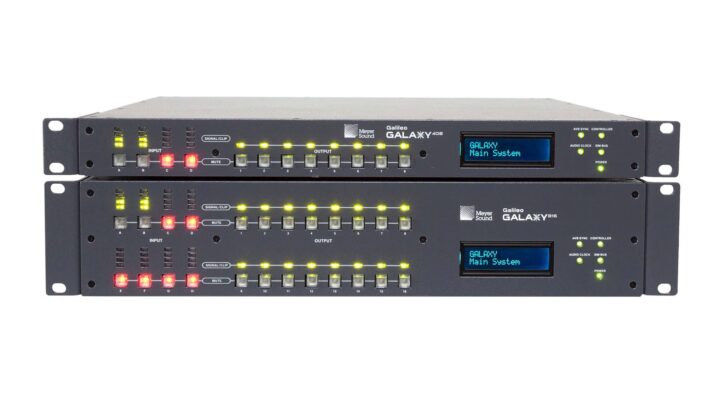 Meyer Sound Galileo GALAXY is Milan-certified and utilizes open-source AVB technology to driving and aligning loudspeaker systems with multiple zones. It provides a powerful toolset for corrective equalization and creative fine-tuning, in applications from touring to cinema. Building on Galileo’s algorithms, GALAXY retains users’ favorite processing tools, including the patented five-band U-Shaping and parametric EQ, while adding a new crosspoint delay matrix feature and improved delay integration. Three versions are available for different configuration needs. The newest generation of FPGA-based processing with up to 64-bit resolution delivers increased dynamic range, a lower noise floor, and super-low latency of 0.6ms analog in to analog out.
Meyer Sound Galileo GALAXY is Milan-certified and utilizes open-source AVB technology to driving and aligning loudspeaker systems with multiple zones. It provides a powerful toolset for corrective equalization and creative fine-tuning, in applications from touring to cinema. Building on Galileo’s algorithms, GALAXY retains users’ favorite processing tools, including the patented five-band U-Shaping and parametric EQ, while adding a new crosspoint delay matrix feature and improved delay integration. Three versions are available for different configuration needs. The newest generation of FPGA-based processing with up to 64-bit resolution delivers increased dynamic range, a lower noise floor, and super-low latency of 0.6ms analog in to analog out.
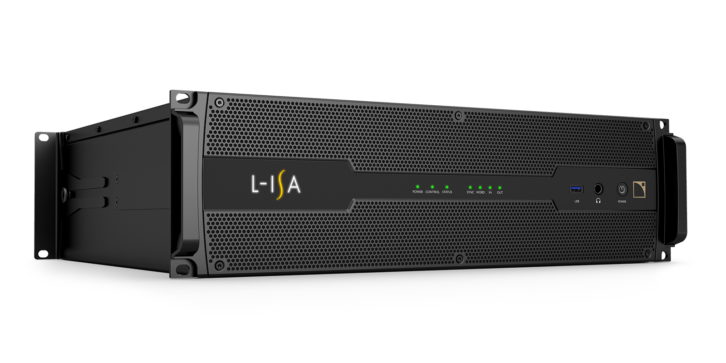 The L-Acoustics L-ISA Processor II is a second-generation hardware solution that provides advanced object-based mixing for immersive audio productions. Like its predecessor, it supports spatial audio processing and virtual acoustics for up to 96 audio objects based on speaker positioning information and mixing parameters—including pan, width, distance, elevation, and aux send—the new L-ISA Processor II doubles the original unit’s potential output count of 64 up to 128 outputs for greater power and versatility on larger, more complex events. Seeing that most productions are unlikely to utilize 100-plus outputs, L-Acoustics is offering L-ISA Processor II in a choice of four output counts—16, 32, 64 or 128—from the same device, with various capacities accessible via different lifetime licenses at tiered pricing levels. For example, a small club or theater may need no more than 16 outputs, while a mid-sized house of worship or performing arts center might require as many as 32. With L-ISA Processor II, those customers now have access to all of the very same immersive tools, 128 inputs and premium quality 96 kHz sampling as large-scale musicals or massive tours running triple-digit outputs, but at a scalable cost.
The L-Acoustics L-ISA Processor II is a second-generation hardware solution that provides advanced object-based mixing for immersive audio productions. Like its predecessor, it supports spatial audio processing and virtual acoustics for up to 96 audio objects based on speaker positioning information and mixing parameters—including pan, width, distance, elevation, and aux send—the new L-ISA Processor II doubles the original unit’s potential output count of 64 up to 128 outputs for greater power and versatility on larger, more complex events. Seeing that most productions are unlikely to utilize 100-plus outputs, L-Acoustics is offering L-ISA Processor II in a choice of four output counts—16, 32, 64 or 128—from the same device, with various capacities accessible via different lifetime licenses at tiered pricing levels. For example, a small club or theater may need no more than 16 outputs, while a mid-sized house of worship or performing arts center might require as many as 32. With L-ISA Processor II, those customers now have access to all of the very same immersive tools, 128 inputs and premium quality 96 kHz sampling as large-scale musicals or massive tours running triple-digit outputs, but at a scalable cost.
 Lectrosonics had versatility in mind when it developed the Lectrosonics Aspen SPN2412, with its 24 inputs and 12 outputs, which can be expanded to many more. The Proportional Gain Algorithm allows it to work seamlessly with other sound gear, while data, audio, and control signals are carried through a single Cat-6 cable. Setup is aided by automatic master/ slave detection and its automatic mixing parameters and presets are extensive including multizone mix minus configuration. The Phantom Mix mode lets the mixing come from multiple zones and fed back into only those zones that are selected for the feed. And with TCP/IP addressability for control through ethernet, it can be part of your network.
Lectrosonics had versatility in mind when it developed the Lectrosonics Aspen SPN2412, with its 24 inputs and 12 outputs, which can be expanded to many more. The Proportional Gain Algorithm allows it to work seamlessly with other sound gear, while data, audio, and control signals are carried through a single Cat-6 cable. Setup is aided by automatic master/ slave detection and its automatic mixing parameters and presets are extensive including multizone mix minus configuration. The Phantom Mix mode lets the mixing come from multiple zones and fed back into only those zones that are selected for the feed. And with TCP/IP addressability for control through ethernet, it can be part of your network.
 Last October, the Mackie M•Caster Studio debuted as the new flagship of the M•Caster Series of Live Streaming Mixers. Designed to be the heart and hub for Twitch-based gamers, YouTube Live creators, podcasters, and live streaming professionals. Features include a built-in sampler and full color MixViewer display. For Twitch-based, fast-paced content creation, M•Caster Studio plugs in directly ATEN Podcast or connects via Bluetooth and offers integrated ContourFX presets, and voice manipulation via the StreamFX feature.
Last October, the Mackie M•Caster Studio debuted as the new flagship of the M•Caster Series of Live Streaming Mixers. Designed to be the heart and hub for Twitch-based gamers, YouTube Live creators, podcasters, and live streaming professionals. Features include a built-in sampler and full color MixViewer display. For Twitch-based, fast-paced content creation, M•Caster Studio plugs in directly ATEN Podcast or connects via Bluetooth and offers integrated ContourFX presets, and voice manipulation via the StreamFX feature.
 The Solid State Logic Live L650 console and its smaller L450 sibling— combined with the SSL Live V5 software — is pitched for installed sound, event space audio, and touring productions. The layout of both desks is based around the triple-wide fader bank configuration also found on the L200 console. Cutaways for external screens are also incorporated to help maintain line of sight to the artist and stage, creating two areas of focus for the operator. The L650 console shares the same knob-per-function Channel Control tile as the L550 Plus, while the L450 features a tablet panel for use with SSL Live’s control app, TaCo.
The Solid State Logic Live L650 console and its smaller L450 sibling— combined with the SSL Live V5 software — is pitched for installed sound, event space audio, and touring productions. The layout of both desks is based around the triple-wide fader bank configuration also found on the L200 console. Cutaways for external screens are also incorporated to help maintain line of sight to the artist and stage, creating two areas of focus for the operator. The L650 console shares the same knob-per-function Channel Control tile as the L550 Plus, while the L450 features a tablet panel for use with SSL Live’s control app, TaCo.
In October, the Solid State Logic ORIGIN analogue range expanded with a new 16-channel variant. Joining it’s larger 32-channel sibling, ORIGIN 16 has the same features, intelligent hybrid workflows and SSL sound quality, all in a smaller footprint—ideal for project studios, music technology schools and colleges, as well as producer rooms or smaller record/mix facilities.
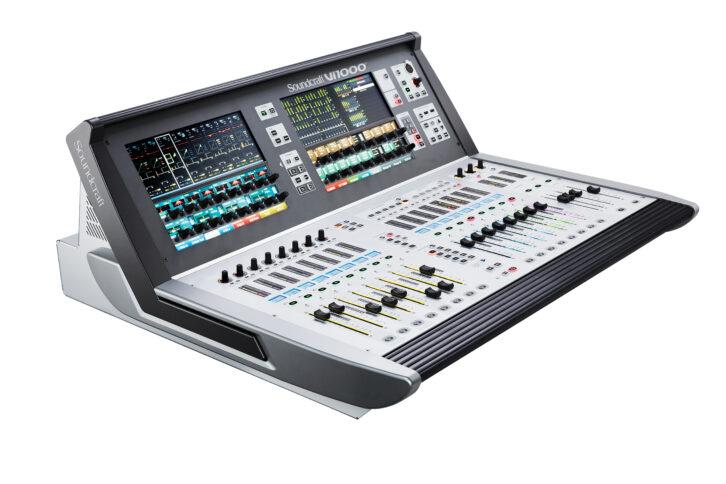
The Soundcraft by HARMAN Vi1000 digital mixing console is a 34in. x 32in. compliment to its two larger siblings, the Vi2000 and 3000. The Vi1000 employs Soundcraft’s Vistonics II channel strip user interface, as well as SpiderCore, a built-in DSP and I/O engine based on STUDER technology, offering 40-bit floating point processing. The Vi1000 features an additional remote-control surface for any of the larger consoles in the range using their Mirroring feature. The Vi1000 comes with rear panel local I/O featuring 16 HQ mic/line inputs, 16-line outputs, and two 64-channel expansion slots that allow up to two MADI-based Stageboxes to be connected, or alternatively the slots provide access to an extensive range of D21m I/O option cards that address all industry-standard audio formats. Four channels of AES/EBU I/O plus USB and MIDI connections complete the back panel. The total I/O count of the console is 212 in x 212 out.
 With the StudioLive 64S, PreSonus the power of a large production console is available to small-format digital mixing, with 76 mixing channels, 43 buses, and 526 simultaneous effects thanks to the quad-core FLEX DSP engine. StudioLive 64S mixers feature an independent main Mono/Center bus; each channel has a dedicated level control and a Center Divergence control that allows users to control the pan placement in their LCR mix. Powered by the PreSonus FLEX DSP Engine, it features state-space modeled Fat Channel plug-in processing on every input and bus; up to 32 FlexMix buses that can be individually configured as Aux, Matrix, or Subgroup buses; and flexible digital patching. It delivers 128-channel (64×64) USB recording, plus multitrack SD recording and extensive 128-channel AVB networking
With the StudioLive 64S, PreSonus the power of a large production console is available to small-format digital mixing, with 76 mixing channels, 43 buses, and 526 simultaneous effects thanks to the quad-core FLEX DSP engine. StudioLive 64S mixers feature an independent main Mono/Center bus; each channel has a dedicated level control and a Center Divergence control that allows users to control the pan placement in their LCR mix. Powered by the PreSonus FLEX DSP Engine, it features state-space modeled Fat Channel plug-in processing on every input and bus; up to 32 FlexMix buses that can be individually configured as Aux, Matrix, or Subgroup buses; and flexible digital patching. It delivers 128-channel (64×64) USB recording, plus multitrack SD recording and extensive 128-channel AVB networking
 The RCF MZ8060 is a versatile 8×6 digital audio matrix mixer built on the foundation of RCF’s RDNet DSP platform. RDNet is a proprietary protocol for RCF loudspeaker products that provides dedicated networking software that makes is possible to control and monitor all system components and parameters. The DSP allows for configurable system programming including room combining, automatic level control, along with all audio input and output criteria including EQs, gates, compressors, limiters, delays, priorities, and levels. The MX8060 features eight universal mic/ line inputs with six balanced outputs along with 10 programmable logic inputs and six programmable logic outputs. It features eights universal mic/ line inputs with 48V phantom power and full audio processing, six hi-level routable balanced outputs with full audio processing, 10 programmable logic inputs (GPI), and six programmable logic outputs (GPO).
The RCF MZ8060 is a versatile 8×6 digital audio matrix mixer built on the foundation of RCF’s RDNet DSP platform. RDNet is a proprietary protocol for RCF loudspeaker products that provides dedicated networking software that makes is possible to control and monitor all system components and parameters. The DSP allows for configurable system programming including room combining, automatic level control, along with all audio input and output criteria including EQs, gates, compressors, limiters, delays, priorities, and levels. The MX8060 features eight universal mic/ line inputs with six balanced outputs along with 10 programmable logic inputs and six programmable logic outputs. It features eights universal mic/ line inputs with 48V phantom power and full audio processing, six hi-level routable balanced outputs with full audio processing, 10 programmable logic inputs (GPI), and six programmable logic outputs (GPO).
 The Shure IntelliMix P300 conferencing mixer connects up to 10 Dante audio inputs, two analog inputs, a USB soft codec, and mobile device. Each input channel can be auto-mixed and provides acoustic echo cancellation, noise reduction, automatic gain control, matrix mixing, delay, compressor, and PEQ. An additional 3.5mm connection enables attendees to join by tablet or phone, and all this fits into a half-rack space package. It connects to room systems through two input and two output terminal blocks while its ethernet connection can use PoE to eliminate a separate power supply. Additionally, a predefined matrix and presets can simplify the setup process. Zoom and Teams certified.
The Shure IntelliMix P300 conferencing mixer connects up to 10 Dante audio inputs, two analog inputs, a USB soft codec, and mobile device. Each input channel can be auto-mixed and provides acoustic echo cancellation, noise reduction, automatic gain control, matrix mixing, delay, compressor, and PEQ. An additional 3.5mm connection enables attendees to join by tablet or phone, and all this fits into a half-rack space package. It connects to room systems through two input and two output terminal blocks while its ethernet connection can use PoE to eliminate a separate power supply. Additionally, a predefined matrix and presets can simplify the setup process. Zoom and Teams certified.
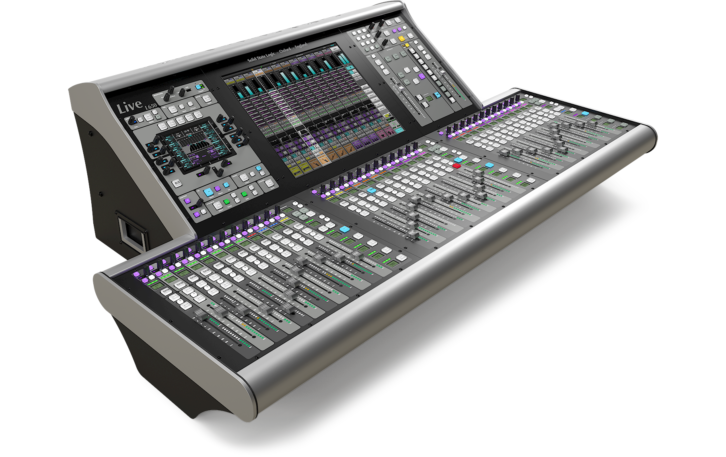 At ISE 2022, Solid State Logic featured the company’s significant new product launch, the new SSL Live L650 console and V5.0 software. The new SSL Live 650 console and its smaller L450 sibling— combined with the new SSL Live V5 software — deliver all the power needed for the next generation of installed sound, event space audio, and touring productions. The layout of both desks will be based around the triple-wide fader bank configuration currently found on the L200 console. Cutaways for external screens are also incorporated to help maintain line of sight to the artist and stage, creating two areas of focus for the operator. The L650 console shares the same knob-per-function Channel Control tile as the L550 Plus, while the L450 features a tablet panel for use with SSL Live’s control app, TaCo. While no set timeframe has been announced for the new consoles’ release, an SSL statement says the company “will begin rolling out” the desks as more tours and events come back. In addition to the new consoles, ‘Plus Processing Packs’ are now available for the existing SSL Live console range as users look to keep their current SSL Live inventory at the cutting edge of production capabilities.
At ISE 2022, Solid State Logic featured the company’s significant new product launch, the new SSL Live L650 console and V5.0 software. The new SSL Live 650 console and its smaller L450 sibling— combined with the new SSL Live V5 software — deliver all the power needed for the next generation of installed sound, event space audio, and touring productions. The layout of both desks will be based around the triple-wide fader bank configuration currently found on the L200 console. Cutaways for external screens are also incorporated to help maintain line of sight to the artist and stage, creating two areas of focus for the operator. The L650 console shares the same knob-per-function Channel Control tile as the L550 Plus, while the L450 features a tablet panel for use with SSL Live’s control app, TaCo. While no set timeframe has been announced for the new consoles’ release, an SSL statement says the company “will begin rolling out” the desks as more tours and events come back. In addition to the new consoles, ‘Plus Processing Packs’ are now available for the existing SSL Live console range as users look to keep their current SSL Live inventory at the cutting edge of production capabilities.
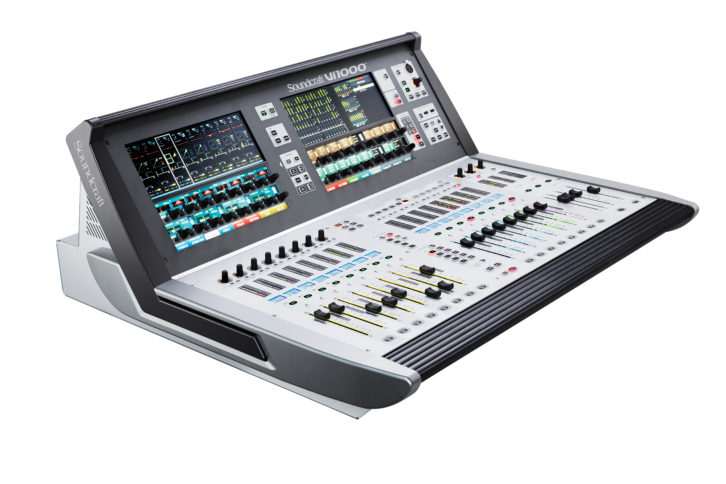
Soundcraft by HARMAN offers the Vi1000 digital mixing console, a 34in. x 32in. compliment to its two larger siblings, the Vi2000 and 3000. The Vi1000 employs Soundcraft’s Vistonics II channel strip user interface, as well as SpiderCore, a built-in DSP and I/O engine based on STUDER technology, offering 40-bit floating point processing. The Vi1000 features an additional remote-control surface for any of the larger consoles in the range using their Mirroring feature. The Vi1000 comes with rear panel local I/O featuring 16 HQ mic/line inputs, 16 line outputs, and two 64-channel expansion slots that allow up to two MADI-based Stageboxes to be connected, or alternatively the slots provide access to an extensive range of D21m I/O option cards that address all industry standard audio formats. Four channels of AES/EBU I/O plus USB and MIDI connections complete the back panel. The total I/O count of the console is 212 in x 212 out.
 Also in January, the TASCAM Sonicview Recording Mixer line became available as the TASCAM Sonicview 16XP or TASCAM Sonicview 24XP. Both units incorporate a new multi-screen user interface called VIEW (Visual Interactive Ergonomic Workflow) with customizable touch screens, user-definable buttons, and intuitive control software. Integration is supported with 64-In/64- Out Dante interface, a 32-bit/96 kHz multi-channel USB audio interface, built-in 32-track multi-track SD recording, Class 1 Premium mic preamplifiers, and wealth of I/O, as well as compatability with Dante networks and in-line monitoring systems. These mixers include a 96 kHz, 54-bit float FPGA mixing engine, continuous high-definition 96 kHz sampling, and 32-bit analog-to-digital converters.
Also in January, the TASCAM Sonicview Recording Mixer line became available as the TASCAM Sonicview 16XP or TASCAM Sonicview 24XP. Both units incorporate a new multi-screen user interface called VIEW (Visual Interactive Ergonomic Workflow) with customizable touch screens, user-definable buttons, and intuitive control software. Integration is supported with 64-In/64- Out Dante interface, a 32-bit/96 kHz multi-channel USB audio interface, built-in 32-track multi-track SD recording, Class 1 Premium mic preamplifiers, and wealth of I/O, as well as compatability with Dante networks and in-line monitoring systems. These mixers include a 96 kHz, 54-bit float FPGA mixing engine, continuous high-definition 96 kHz sampling, and 32-bit analog-to-digital converters.
TASCAM’s Dante Compact Processor series comprises seven half-rack Dante audio converters featuring onboard digital matrix mixers with signal processing. These Dante-enabled input/ output endpoints deliver up to 24-bit, 96 kHz audio conversion. Dante Compact Processors can be freely combined to create custom systems and are easily installed under desks or on walls with the included surface rack-mount angles or rack-mounted with the optional AK-RS1 rack shelf. All models offer the flexible routing of Audinate’s Dante controller, and are compatible with Dante AES67 mode and Dante Domain Manager. They offer remote control via GPI, Dante, and Solid State Logic L650 Stage Tec AVATUS Soundcraft by HARMAN Vi1000 TECH SHOWCASE, either of two free TASCAM control software applications, one for integrators and one for end users..
 One of the highlights of NAB was the debut of the Waves Cloud MX Audio Mixer with Dante via Audinate’s Dante Connect cloud platform. Waves Cloud MX is a 100% cloud-based audio mixer, for audio, mix control, and creative processing capabilities with Waves plug-in integration. Cloud MX remote operator control options include support for touch screens plus tactile mixing with the Waves FIT Controller. The Waves Cloud MX Audio Mixer is now fully Dante Connectcompatible for up to 256 channels of remote audio capture and full cloud production
One of the highlights of NAB was the debut of the Waves Cloud MX Audio Mixer with Dante via Audinate’s Dante Connect cloud platform. Waves Cloud MX is a 100% cloud-based audio mixer, for audio, mix control, and creative processing capabilities with Waves plug-in integration. Cloud MX remote operator control options include support for touch screens plus tactile mixing with the Waves FIT Controller. The Waves Cloud MX Audio Mixer is now fully Dante Connectcompatible for up to 256 channels of remote audio capture and full cloud production
 The Xilica Solaro QR1 is a quarter-rack Linux-based DSP processor has eight modular card slots that accept 2-channel audio input and output cards and 4-channel GPIO cards selectable as input or output. The ability to use any card type, in any combination, in any card slot maximizes I/O flexibility, and allows designers to specifically customize I/O without waste. A 4×4 Dante card is built-in. Supported by Xilica’s drag-and-drop Designer, it is compatible with various Xilica control interfaces as well as any third-party control system. External power supply included; also PoE. Optional AEC mic inputs up to 8-channels@250ms and 16channels@100ms
The Xilica Solaro QR1 is a quarter-rack Linux-based DSP processor has eight modular card slots that accept 2-channel audio input and output cards and 4-channel GPIO cards selectable as input or output. The ability to use any card type, in any combination, in any card slot maximizes I/O flexibility, and allows designers to specifically customize I/O without waste. A 4×4 Dante card is built-in. Supported by Xilica’s drag-and-drop Designer, it is compatible with various Xilica control interfaces as well as any third-party control system. External power supply included; also PoE. Optional AEC mic inputs up to 8-channels@250ms and 16channels@100ms
 In January, the Yamaha AG08 Second Generation Live Streaming Mixer debuted, combining practical I/O and DSP effexts. The AG08 provides a total of 8 input channels with XLR combo inputs on both channels one and two; channel two is also equipped with Hi-Z input. Input 1 has a voice changer effect, while input 2 is equipped with an amp simulator. Channels 3 and 4 have TRS line-level inputs with a high/low gain switch for dealing with different sources. On channels 5 and 6 are RCA inputs and a 1/8-inch TRS input. Finally, 7 and 8 have a four-pole TRRS socket for Android devices. On the rear panel, the outputs are all +4 dBU. This includes the Monitor Out section with a pair of XLR and TRS outputs and a pair of TRS outs for the Mix Out. In addition, the AG08 can be powered via USB or the supplied power adapter. It supports a wide range of relevant streaming apps for speech, gaming, ASMR, and offline content creation.
In January, the Yamaha AG08 Second Generation Live Streaming Mixer debuted, combining practical I/O and DSP effexts. The AG08 provides a total of 8 input channels with XLR combo inputs on both channels one and two; channel two is also equipped with Hi-Z input. Input 1 has a voice changer effect, while input 2 is equipped with an amp simulator. Channels 3 and 4 have TRS line-level inputs with a high/low gain switch for dealing with different sources. On channels 5 and 6 are RCA inputs and a 1/8-inch TRS input. Finally, 7 and 8 have a four-pole TRRS socket for Android devices. On the rear panel, the outputs are all +4 dBU. This includes the Monitor Out section with a pair of XLR and TRS outputs and a pair of TRS outs for the Mix Out. In addition, the AG08 can be powered via USB or the supplied power adapter. It supports a wide range of relevant streaming apps for speech, gaming, ASMR, and offline content creation.










